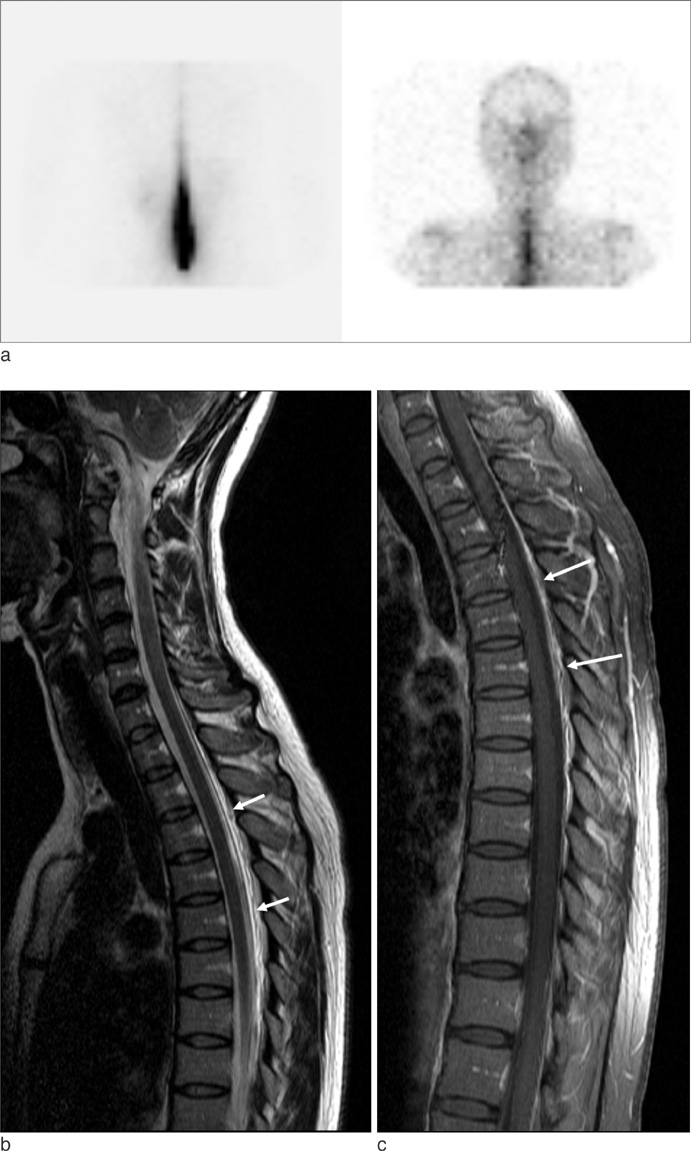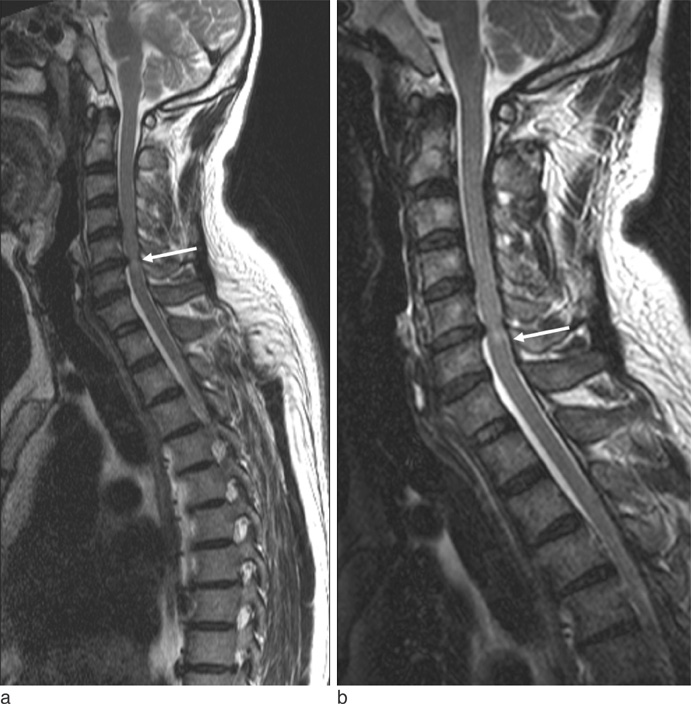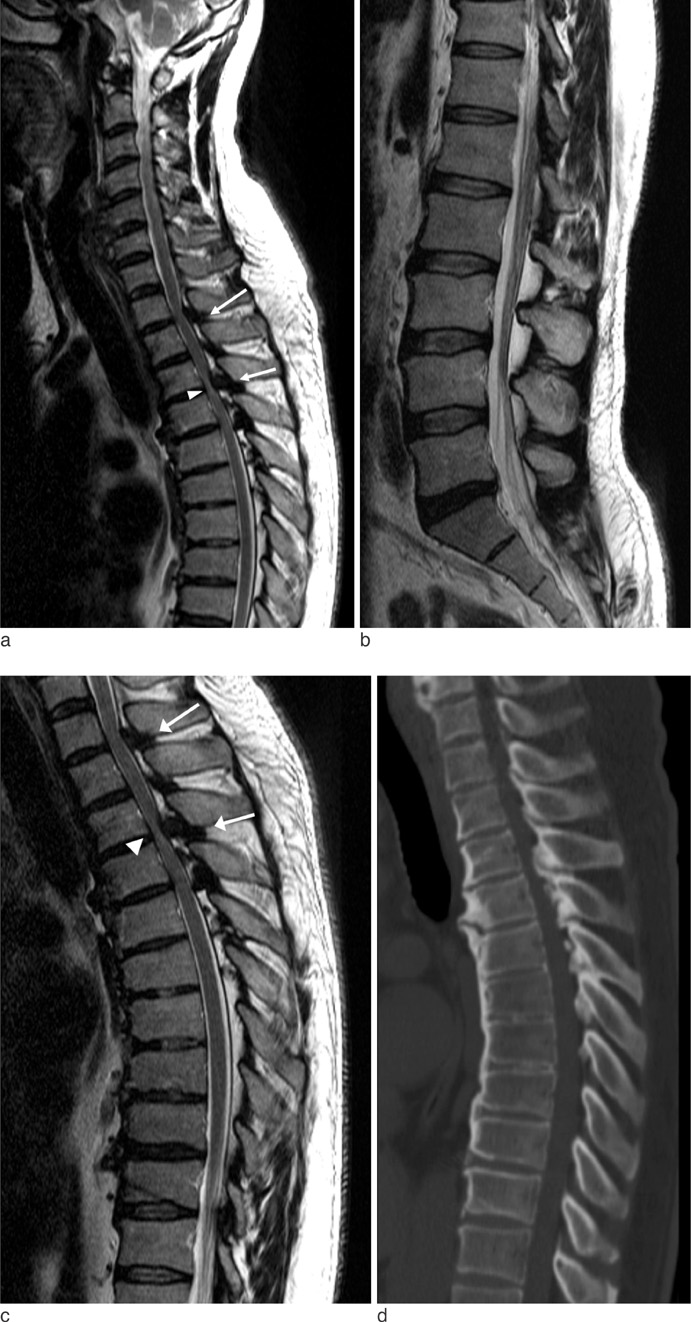J Korean Soc Magn Reson Med.
2013 Jun;17(2):91-100. 10.13104/jksmrm.2013.17.2.91.
The Value of Additional Cervicothoracic Spine Sagittal T2-weighted Images Included in Routine Lumbar Spine MR Imaging
- Affiliations
-
- 1Department of Radiology, Seoul National University Bundang Hospital, Seongnam-si, Gyeonggi-do, Korea. joonwoo2@gmail.com
- KMID: 2099868
- DOI: http://doi.org/10.13104/jksmrm.2013.17.2.91
Abstract
- PURPOSE
To evaluate the usefulness of cervicothoracic spine sagittal T2-weighted images (CT SAG T2WIs) included in routine lumbar spine MRI.
MATERIALS AND METHODS
Institutional review board approval was obtained and informed consents were waived for this retrospective study. The study group comprised 2,113 patients who underwent lumbar spine MRI from January 2005 to December 2005. CT SAG T2WIs were added in the routine lumbar spine MRIs. Radiologic reports were reviewed retrospectively for pathologic lesions on CT SAG T2WIs by one radiologist. Information of additional cervical or thoracic spine MRI and/or CT for further evaluation of positive findings on CT SAG T2WIs and their treatment were collected by retrospectively reviewing medical records.
RESULTS
The CT SAG T2WIs revealed 142 pathologic lesions in 139 (6.58%) of the 2,113 patients. They were easily obtained without positional change in a scan time of less than 2 minutes. Additional cervical or thoracic spine MRI and/or CT for positive findings on CT SAG T2WIs were performed in 13 patients. Seven patients underwent surgical treatment.
CONCLUSION
CT SAG T2WIs included in routine lumbar spine MRI were useful in finding the pathologic lesions in cervicothoracic spine for the patients who assumed to have lesions in lumbar spine.
Figure
Reference
-
1. Muhle C, Metzner J, Weinert D, et al. Classification system based on kinematic MR imaging in cervical spondylitic myelopathy. AJNR Am J Neuroradiol. 1998; 19:1763–1771.2. Potter K, Saifuddin A. MRI of chronic spinal cord injury. British Journal of Radiology. 2003; 76:347–352.3. Watters MR, Stears JC, Osborn AG, et al. Transdural spinal cord herniation: imaging and clinical spectra. AJNR Am J Neuroradiol. 1998; 19:1337–1344.4. Chen CJ, Lee TH, Hsu HL, Tseng YC, Wong YC, Wang LJ. Spinal MR findings in spontaneous intracranial hypotension. Neuroradiology. 2002; 44:996–1003.5. LaBan MM, Green ML. Concurrent (tandem) cervical and lumbar spinal stenosis: a 10-yr review of 54 hospitalized patients. Am J Phys Med Rehabil. 2004; 83:187–190.6. Lee MJ, Garcia R, Cassinelli EH, Furey C, Riew KD. Tandem stenosis: a cadaveric study in osseous morphology. The Spine Journal. 2008; 8:1003–1006.7. Dagi TF, Tarkington MA, Leech JJ. Tandem lumbar and cervical spinal stenosis. Natural history, prognostic indices, and results after surgical decompression. J Neurosurg. 1987; 66:842–849.8. Edwards CC 2nd, Riew KD, Anderson PA, Hilibrand AS, Vaccaro AF. Cervical myelopathy. current diagnostic and treatment strategies. Spine J. 2003; 3:68–81.9. Slipman CW, Shin CH, Patel RK, et al. Etiologies of failed back surgery syndrome. Pain Med. 2002; 3:200–214. discussion 214-207.10. Parmar H, Park P, Brahma B, Gandhi D. Imaging of idiopathic spinal cord herniation. Radiographics. 2008; 28:511–518.11. Wada E, Yonenobu K, Kang J. Idiopathic spinal cord herniation: report of three cases and review of the literature. Spine (Phila Pa 1976). 2000; 25:1984–1988.12. Gandhi D, Goyal M, Bourque PR. Case 138: Idiopathic spinal cord herniation. Radiology. 2008; 249:384–388.
- Full Text Links
- Actions
-
Cited
- CITED
-
- Close
- Share
- Similar articles
-
- Should We Recommend Ultrasonography for an Incidental Thyroid Nodule on Additional Cervicothoracic Sagittal T2-Weighted Image of Lumbar Spine MRI?
- Value of Additional Cervicothoracic Sagittal T2-Weighted Images in Elderly Patients with Symptoms Suggestive of Lumbar Spinal Stenosis
- Clinical Utility of Limited T2-Weighted-Only Lumbar Spine MRI in Pain Intervention Clinics
- Coexisting Spine Lesions on Whole Spine T2 Sagittal MRI in Evaluating Spinal Degenerative Disease
- Incorporation of Whole Spine Screening in Magnetic Resonance Imaging Protocols for Low Back Pain: A Valuable Addition





